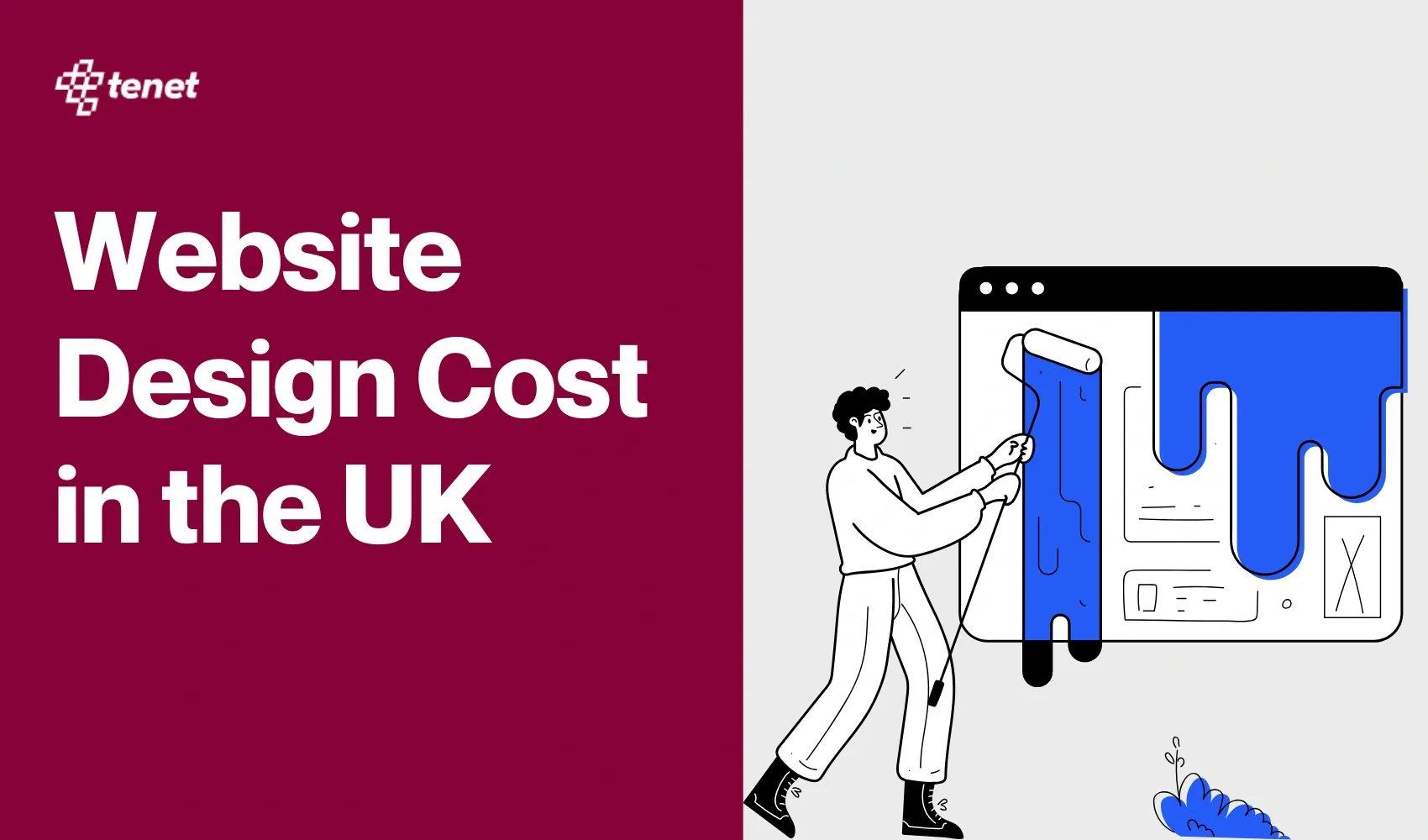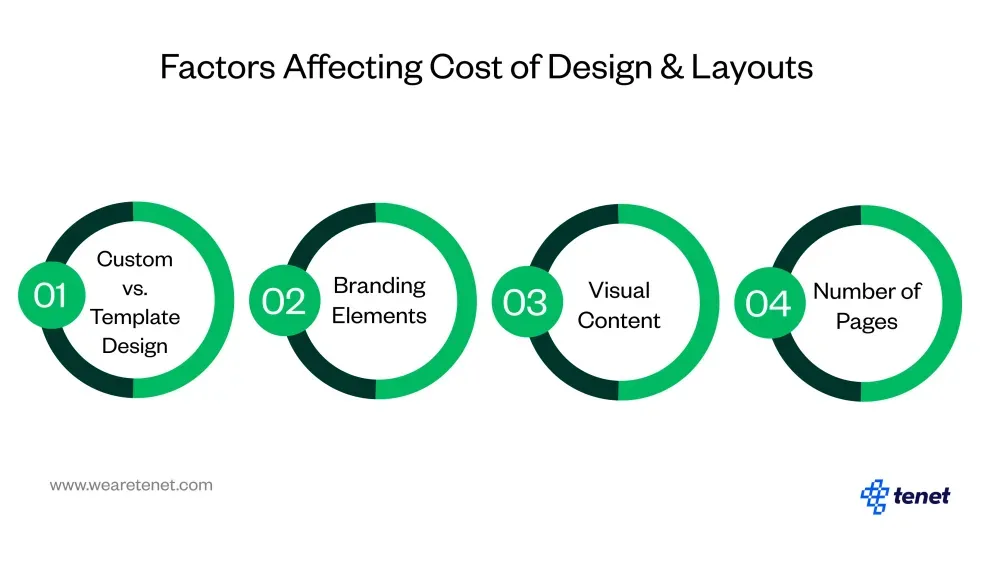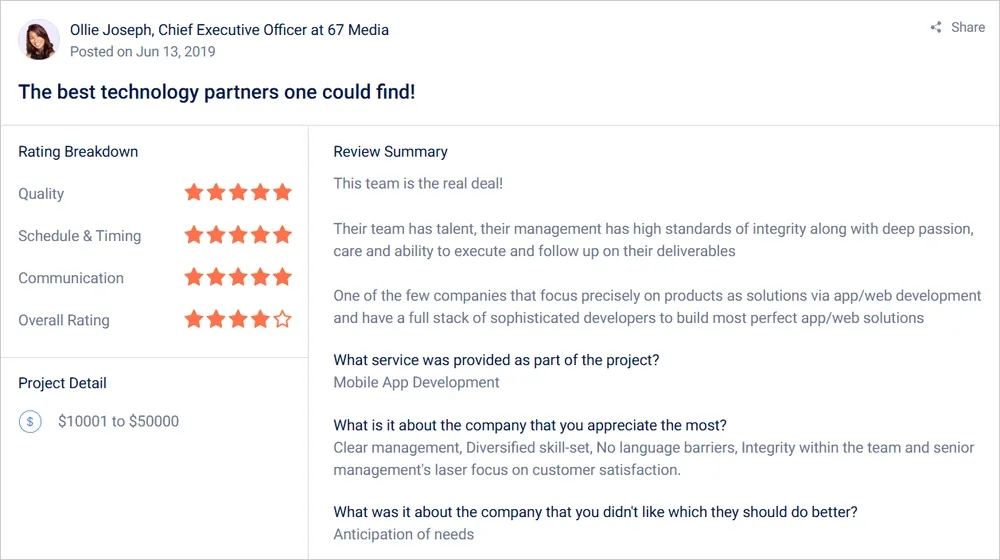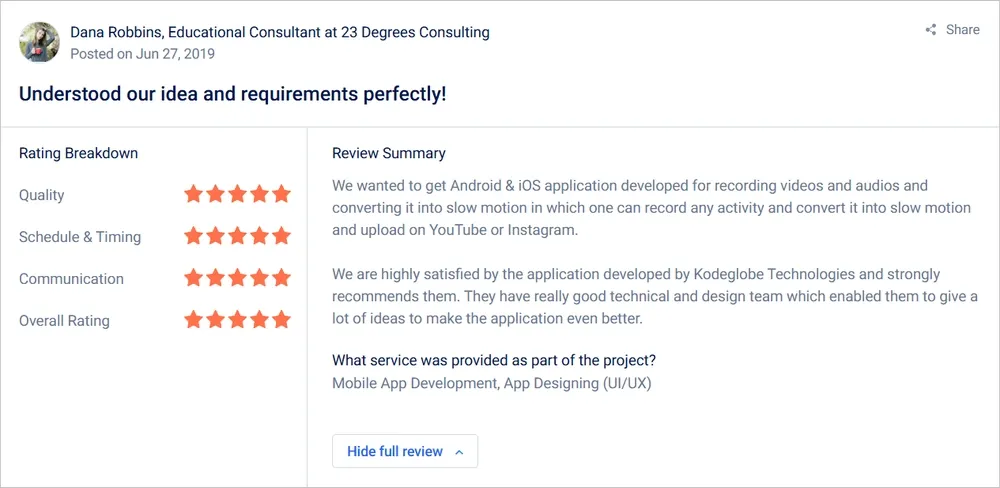Website design cost UK: How much does a website cost in UK?
Share
Share

Wondering how much you should budget for your new website?
Understanding the website design cost in the UK is key to planning a successful project. From basic business sites to complex e-commerce platforms, costs can vary based on design, features, and development needs.
In this guide, we break down everything you need to know about website pricing models, development factors, and ongoing maintenance costs in the UK.
How much does website designing cost in the UK?
Website designing in the UK costs between £500 for a basic informational website and up to £100,000 for complex, highly customized websites with extensive functionalities.
Prices vary based on design complexity, the number of pages, e-commerce features, and custom development requirements.
![Website Design Cost in the UK [2025 Updated]](/_next/image?url=https%3A%2F%2Fd3us4ynq1qsik6.cloudfront.net%2Fuploads%2FUX_Design_Services_71f9924fbe.webp&w=1920&q=85)
The cost of website design in the UK varies based on factors like:
- Website Type: Brochure sites cost less than e-commerce or custom apps.
- Design Complexity: Custom layouts need more time and resources.
- Functionality: Features like payments and integrations add costs.
- Content Volume: More pages mean higher design and development effort.
- Platform: DIY builders (e.g., Wix) are cheaper than custom-coded sites.
- Designer Experience: Agencies charge more than freelancers.
- Hosting & Domain: Costs vary for domain purchase and hosting plans.
- Maintenance & Support: Regular updates and fixes cost extra.
- Content Creation: Professional text, images, or videos raise expenses.
- Timeline: Faster delivery usually means higher charges.
Here is a table showing the general website design cost in the UK:
What are the Factors That Affect the Website Development Cost in the UK?
The type of development team greatly impacts UK website pricing.
Pricing varies based on experience, location, and working model (freelancers, in-house teams, or agencies).
![Website Design Cost in the UK [2025 Updated]](/_next/image?url=https%3A%2F%2Fd3us4ynq1qsik6.cloudfront.net%2Fuploads%2FFrame_56f1cd0a76.webp&w=1920&q=85)
1. Freelancers
A typical experienced webdesign freelancer cost around £30–£60/hour or £200–£400/day. They're affordable for small to mid-sized projects, offering flexibility and direct communication. However, they may lack resources for complex tasks and need closer management.
Pros:
- Cost-effective for smaller projects
- Flexible schedules and direct contact
- Good for specific tasks like design or coding
Cons:
- Limited capacity for large projects
- Potential issues with reliability and deadlines
- Less scalability for bigger needs
2. In-house teams
Hiring full-time developers costs about £30,000/year (roughly 1,000 hours of work). They ensure full control, better communication, and strong brand alignment but involve high salary, training, and operational costs.
Pros:
- Full-time availability for faster response
- Deep understanding of your brand and goals
- Best for ongoing updates and internal systems
Cons:
- High long-term costs (salaries, benefits)
- Limited exposure to diverse techniques
- Less suited for short-term or small projects
3. Web development agencies
Agencies like Tenet charge around £50–£200/hour or £300–£1,000/day. They offer skilled teams, complete solutions (design, development, SEO), and faster delivery, but they are the most expensive option and may lack the personal touch of an in-house team.
Pros:
- Professional websites with custom designs
- Full-service packages including SEO, branding, marketing
- Faster project completion with expert teams
- Ongoing maintenance and security support
Cons:
- Higher costs than freelancers or DIY options
- Potential communication gaps in bigger teams
- May be excessive for small, simple projects
3. Location of Development Team
The location of your development team can have a considerable impact on the cost of website design. The difference in the pricing occurs due to the differences in labor rates, expertise, and operational expenses.
Development teams located in cities with a higher cost of living charge higher than those located in areas with a low cost of living. Here is a table summarizing the cost of website development across the various cities in the UK:
That’s one of the reasons why we have some of our delivery teams in a tech-friendly and highly skilled force country like India, as that helps us deliver exceptional quality and better rates than most agencies in the UK.
4. Features and Functionality
Adding features and functionality can cost between £250 and £5,000+, depending on complexity. These elements improve user experience, engagement, and efficiency but can significantly impact website design costs in the UK. Advanced features require more development, integration, testing, and specialized expertise, increasing time and expenses.
Here is a list of some of the common features and functionality a website must have:
Each additional feature may raise development time, testing, and maintenance costs, which affects the entire website cost.
5. Design and Layout
The average website design cost in the UK ranges from £1,500 to £20,000+, depending on complexity. Simple, template-based designs are cheaper, while custom designs aligned with your brand cost more.
Factors affecting cost:

- Custom vs. Template Design: Custom websites (£2,000–£20,000+) are costlier than template-based ones (£500–£2,500).
- Branding Elements: Creating logos, colors, and fonts can add £5,000–£30,000.
- Visual Content: Stock media costs £100–£500; custom photography/videos cost £2,000–£10,000.
- Number of Pages: Small sites (1–10 pages) cost £1,000–£2,000; large sites (150–200 pages) cost £10,000–£20,000.
6. Development and Programming
The average cost of website development and programming in the UK ranges from £1,000 to £15,000.
Basic websites using CMS platforms like WordPress are cheaper and quicker to build. Custom coding, backend development, and special features like third-party integrations increase the cost.
The programming language and development framework used also impact pricing. Advanced tools or certifications raise development expenses.
Testing, debugging, website speed optimization, security measures, and ensuring web standards compliance add to the final development cost.
7. Third-Party Integrations
Adding third-party integrations to a website costs between £500 and £3,500.
Integrations connect your site with tools like payment gateways, CRM systems, social media, and analytics platforms.
Costs increase with the number, complexity, and customization of integrations. Custom work also requires extra testing, debugging, and maintenance, raising the final development cost.
Some of the most common third-party integrations that you can add to your website include the following:
8. Domain and Hosting
The cost of acquiring and maintaining a domain is determined by several factors. They are as follows:
On the other hand, hosting is the service that keeps your website's files and makes them available online.
The type of hosting you choose has a considerable impact on pricing, with storage space, server type, traffic capacity, and other services all influencing the price.
Hosting expenses are recurring and vary depending on the size, traffic, and requirements of the website.
It is an important factor to consider when budgeting for website development. Here is a table with the popular hosting company and their associated plans:
9. Content Creation
Content development and creation comprise creating text, photographs, videos, and other media to populate your website. The kind, quality, and volume of content have a considerable impact on prices.
Here is the breakdown of the various aspects related to content creation and the associated costs:
10. Testing and Quality Assurance cost
Testing and quality assurance (QA) cost 2% to 15% of the total website development cost, averaging £3,000 to £7,000.
QA checks website performance, responsiveness, and security before launch. It identifies bugs, improves user experience, prevents security risks, and ensures the site meets business and user needs.
The cost of testing based on its types are as follows:
This process needs time, tools, and experience, which increases the entire development cost.
12. Maintenance and Support Cost
In general, website maintenance and support cost between £500 and £3,000 per month in the UK. Maintenance includes regular updates, security patches, content changes, and technical support to keep the website running smoothly.
Websites with high traffic or frequent updates need more intensive maintenance, increasing ongoing ownership costs based on size and complexity.
Some of the factors that influence the maintenance and support cost of a website are as follows:
Website design pricing models in the UK
Website design costs in the UK depend heavily on the pricing model you choose. Here’s a detailed breakdown:
Project-Based (Fixed) Pricing
How It Works:
In project-based pricing, the client and designer agree on a fixed cost before any work starts.
The full scope of work, timelines, and deliverables are discussed and locked in upfront.
Once finalized, any additional work outside the agreed scope is billed separately.
Best For:
- Small to medium websites with a clearly defined structure.
- Businesses that want a one-time design project (e.g., blogs, portfolios, company websites).
Pros:
- Predictable Costs: No unexpected charges once the project begins.
- Clear Deliverables: Everyone knows what’s included.
- Set Deadlines: Project usually finishes on schedule.
Cons:
- Limited Flexibility: Adding new features later can be expensive.
- Scope Creep Risk: Any extra requests can increase costs.
Typical Cost Range:
Hourly Pricing
How It Works:
In hourly pricing, the designer or agency tracks time spent on each task (design, development, revisions, meetings).
The final bill is calculated by multiplying total hours by the agreed hourly rate.
There’s no fixed final cost — you pay as work progresses.
Best For:
- Projects with evolving or unclear requirements.
- Businesses needing continuous updates, maintenance, or small design changes.
Pros:
- High Flexibility: Adjust project requirements anytime.
- Pay Only for Work Done: Ideal if you need work in phases.
- Good for Long-Term Support: Useful for website updates over months or years.
Cons:
- Unpredictable Total Cost: Hard to estimate final expenses.
- Open Timelines: Longer projects may increase costs.
Typical Hourly Rates:
Value-Based Pricing
How It Works:
Value-based pricing sets the project cost based on the business value or return on investment (ROI) the website is expected to generate.
Instead of billing based on hours worked or project size, the price reflects the website’s potential to drive leads, sales, or brand growth.
The designer evaluates the business impact first, then proposes a price accordingly.
Best For:
- Businesses where the website will directly influence revenue growth.
- High-value websites that drive lead generation, e-commerce sales, or brand positioning.
Pros:
- Focus on Results: Pricing linked to measurable business outcomes.
- Fixed Pricing: Clear understanding of the total cost at the start.
- Justifies Premium Pricing: Greater potential ROI for the client.
Cons:
- Higher Initial Cost: Premium investment upfront.
Uncertain ROI: Results may depend on factors outside the designer’s control.
Typical Cost Estimate:
5% to 20% of the website’s projected annual revenue.
Website design and development cost calculator (UK)
Website design and development costs in the UK vary based on project scope, customization level, number of pages, and features like e-commerce, booking systems, or custom applications.
General website design cost formula:
![Website Design Cost in the UK [2025 Updated]](/_next/image?url=https%3A%2F%2Fd3us4ynq1qsik6.cloudfront.net%2Fuploads%2FChatbots_a81f39542d.webp&w=1920&q=85)
Total Website Cost (UK) = (Customization Level + Number of Pages + Features + Testing + Maintenance + Hosting Costs)
Looking for an exact UK-based website quote?
Hire our UK web design experts and get a detailed quotation within 24 hours — no hidden fees, fully tailored to UK standards and pricing.
What’s the ROI of Website Designing and Development?
Investing in website design and development can provide a high return on investment (ROI) once it starts to support the business objectives and drives growth. Here are 6 ways a well-designed website can deliver ROI:
![Website Design Cost in the UK [2025 Updated]](/_next/image?url=https%3A%2F%2Fd3us4ynq1qsik6.cloudfront.net%2Fuploads%2FUX_Design_Cost_dd299da5b2.webp&w=1920&q=85)
1. Increased Revenue
Around 75% of visitors perceive well-designed websites as more trustworthy, which directly influences their decision to engage with your brand. Hence, a well-optimized website attracts more visitors and encourages them to visit it again. It also helps in better sales or lead generation, directly boosting revenue, especially for e-commerce businesses.
2. Improved User Experience
Did you know that 88% of web users leave a website after a poor website experience? Hence, having a user-friendly, easy-to-navigate website improves visitor happiness, reduces bounce rates, and increases time spent on the site. This results in better engagement and conversions.
3. Higher Conversion Rates
An optimized design can improve the conversion rate by up to 400%. Hence, adding components such as clear calls-to-action, easy checkout, and responsiveness increases conversion rates. This encourages users to take the desired actions.
👉 Learn how much does conversion rate optimization services cost
4. Cost Savings
Automating essential activities such as customer support, booking systems, and payment gateways can eliminate manual input. This helps save costs and increase efficiency.
5. Brand Credibility and Trust
As per research, consistent branding can boost the company’s revenue by 23%. Thus, a good website helps you do its branding. This helps in increasing credibility and trust, resulting in increased loyalty, referrals, and repeat business.
6. Effective Marketing
A well-designed website boosts SEO, which allows you to integrate PPC campaigns. It also helps in promoting your social media channels, resulting in increased traffic and ROI toward digital marketing strategies.
The ROI of website design and development goes beyond monetary gains. Thus, investing in website design yields an obvious return by promoting growth, efficiency, and brand trust in the long run.
Why Choose Tenet for Your Website Development Project?
So, are you ready to start your website design and development project? Then, reach out to us. You may wonder why. So, here is why!
Tenet is a renowned UI/UX design and growth marketing company holding an experience of more than 7 years. Over this journey, we have successfully helped 300+ clients and completed 450+ projects.
With a stellar record of 98% client satisfaction, our solutions have helped our client generate more than $1.54 billion in revenue & investments. Our solutions have impacted the lives of 20+ million people globally. Here is what our clients are saying about us

Here is another one:

We provide more than 30 services, such as Brand Research, Brand Strategy, UX Research, UI UX Design, Website Development, Search Engine Optimization (SEO), Growth Marketing, and several more.
Our clients choose us over our competitors because of our understanding of the industry and the ownership we bring to the table. We are definitely not the cheapest agency in the market, but we can vouch that we can help you reach your vision by making it our own.
All you need to bring is your idea and vision, and the rest of our team will work alongside you to get it to reality. Still not sure?
You can also see our portfolio to learn about our expertise.
👉 Find our curated list of UI/UX Design Companies (UK)
Frequently Asked Questions
How long does it take to design a website in the UK?
Designing a website in the UK can take 2 to 24 weeks. Simple websites typically require 2 to 4 weeks, while enterprise-level websites may take up to 24 weeks. Timeline factors include complexity, client feedback, revisions, project size, customization level, and functionality.
Is it worth hiring a professional web designer in the UK?
Hiring a professional web designer in the UK is worthwhile for building high-quality, functional, and user-friendly websites. Professional designers apply expertise in design, user experience (UX), and SEO, creating polished websites that drive brand growth and conversions.
Can I design my own website to save costs?
You can design your own website using builders like Wix, Squarespace, or WordPress. These tools allow drag-and-drop website creation without coding skills. However, learning them takes time, and self-designed sites may lack the polish and advanced functionality of professional designs.
How much should I expect to pay for a website design?
In the UK, website design costs range from £500 for basic websites to over £100,000 for fully customized designs. For a free quote, you can fill out our form and receive an expert quotation within 24 hours.
What’s the best company for web designing in the UK?
Tenet is the best web designing company in the UK. With 7 years of experience, Tenet specializes in UI/UX design, web development, and growth marketing, helping over 350 clients generate more than $1.54 billion through scalable and powerful UX solutions.
How much does it cost to design and maintain a website in the UK?
Website design costs in the UK range from £500 to over £100,000. Maintenance costs vary between £500 and £3,000 per month. Factors influencing costs include project complexity, website size, customization level, and additional functionality.
Expertise Delivered Straight to Your Inbox
Expertise Delivered Straight to Your Inbox

Got an idea on your mind?
We’d love to hear about your brand, your visions, current challenges, even if you’re not sure what your next step is.
Let’s talk
























